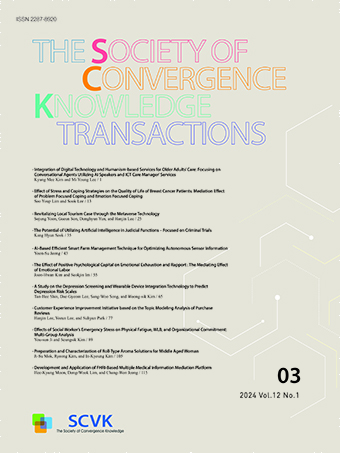Research Article
Abstract
References
Information
본 논문은 치매의 예방 및 개선에 이용되는 미술치료에 있어서 미술치료 매체로써 푸드펜을 활용한 서비스를 제안한다. 치매는 아직 치료제가 없어 예방 및 완화만이 유일한 대안인데, 미술치료는 접근성 및 사용 용이성이 좋아서 치매의 예방과 개선 서비스로 일반적으로 활용되고 있다. 미술치료 서비스는 아날로그적 대면 서비스로써 미술치료 전문가에 의존하므로 일반화 및 객관화에 한계가 있다고 지적하고 있다. 최근 4차산업혁명 시대를 맞아 미술치료 분야도 디지털과의 융합을 통하여 다양한 시도가 진행되고 있다. 즉 디지털 특성인 항상성과 변형 가능성, 결합성, 재생산성을 이용하여 치매 서비스로써 미술치료를 다양하게 접근하고 분석하고 있다. 따라서 본 연구는 이러한 치매 관련 서비스의 고도화에 발맞추어, 아날로그-디지털 미술치료 매체로써 푸드펜을 적용하는 서비스를 제안한다. 이를 위하여 선행연구로부터 치매에 대한 미술치료의 효과를 파악하고 치매와 관련하여 고도화되고 있는 트렌드를 체계적으로 분석하였다. 이를 바탕으로 미술치료 매체로써 디지털-아날로그 융합장치인 푸드펜을 미술치료에 어떻게 적용할 것인가와 어떻게 분석할 것인가에 대한 연구 문제를 도출하고 기존의 미술치료 매체들과의 차별성을 분석하였다.
This paper proposes a service using a food pen as an art therapy materials in art therapy used for the prevention and improvement of dementia. There is no cure for dementia, so prevention and alleviation are the only alternatives, but art therapy is generally used because of its accessibility and ease of use. Art therapy service is an analog face-to-face service, and it is pointed out that there is a limit to generalization and objectification because analysis depends on art therapy experts. Recently, various attempts are being made through convergence with digital. In other words, various analyzes and advancements are being made using digital characteristics such as homeostasis, transformability, compatibility, and reproducibility. Therefore, this study proposes a service that applies the food pen as an analog-digital art therapy materials in line with the advancement of dementia-related services. To this end, the effects of art therapy on dementia were identified from previous studies, and the advanced trends related to dementia were systematically analyzed. Based on this, the research questions on how to apply and analyze the food pen, a digital-analog fusion device as an art therapy medium, were pointed out and the differentiation from the existing art therapy media was analyzed.
- 보건복지부, 중앙치매센터, "2016 전국치매역학조사", NIDR-1603-0015, 2016.
- E. S. Oh, and A. E. Lee, "Mild Cognitive Impairment", Journal of the Korean Neurological Association, Vol. 34, No. 3, pp. 167-175.https://doi.org/10.17340/jkna.2016.3.1
- 김영선, "치매돌봄기술의 현재와 향후 발전 방향", 보건복지포럼, 통권 제276호, pp.42-57, 2019.
- 남현우, "시니어 인지반응 융합콘텐츠 기술 방향성 연구", 한국과학예술융합학회, 제30권, pp.57-69, 2017.https://doi.org/10.17548/ksaf.2017.09.30.57
- 보건복지부, "2018-2022 제2차 장기요양 기본계획(안)", 2018.
- 최호진, "치매국가책임제와 치매종합관리계획", 의학신문, https://www.bosa.co.kr/news/articleView.html?idxno=2134731
- R. C. Petersen, "Mild Cognitive Impairment as a Diagnostic Entity", Journal of Internal Medicine, Vol. 256, No. 3, pp. 183-194.https://doi.org/10.1111/j.1365-2796.2004.01388.xPMid:15324362
- 중앙치매센터, "치매현황", 2021년 2월, https://www.nid.or.kr/main/main.aspx , 2021.
- 통계청, "2020고령자 통계", http://kostat.go.kr/portal/korea/kor_nw/1/1/index.board?bmode=read&aSeq=385322 , 2020.
- 정민영, 박천규, 손명동, "오감 자극 노인성 치매 예방 프로그램", 한국콘텐츠학회 2010년도 춘계종합학술대회 논문집, pp.594-600, 2010.
- 김귀분, "노인치매의 현황과 전망", 대한간호, 제37권 제1호, pp.16-24, 1998.
- 김양이, "치매노인 가족을 위한 단상", 지역사회, 제62권, pp.79-84, 2010.
- 이해영, "케어복지개론", 양서원, 2004.
- R. M. Eisler, P. M. Miller, and M. Hersen, "Components of Assertive Behavior", Journal of Clinical Psychology, Vol. 29, No. 3, pp. 295-299, 1973.https://doi.org/10.1002/1097-4679(197307)29:3<295::AID-JCLP2270290305>3.0.CO;2-9
- R. Lubinski, "Learned Helplessness: Application to Communication of the Elderly", Dementia and Communication, pp. 142-151, 1991.
- 최옥순, 박경숙, "경증 치매노인을 위한 푸드표현 예술치료 프로그램이 인지기능, 자기표현 및 우울에 미치는 효과", 노인복지연구, 제74권 제3호, pp.29-63, 2019.https://doi.org/10.21194/kjgsw.74.3.201909.29
- 이석범, "알츠하이머병에 대한 비약물적 개입", 대한의사협회지, 제52권 제11호, pp.1069-1076, 2009.
- 김혜진, "데이터 3법이 치매 조기 예측을 위한 의료 빅데이터 활용에 미치는 영향 연구", 디지털융복합연구, 제18권 제5호, pp.305-315, 2020.
- 김민용, 김지유, "푸드표현 예술치료 이해와 실제", 양서원, 2011.
- 김동연, "미술치료의 이론과 실제", 현장특수교육, pp.125-131, 1994.
- 이수경, "노인을 위한 미술교육 프로그램", 공주대학교 교육대학원 석사학위논문, 2015.
- 김연희, "치매노인대상 미술치료 프로그램의 인지기능 증진 효과에 대한 메타분석", 원광대학교 석사학위논문, 2018.
- A. L. Cowl, and J. E. Gaugler, "Efficacy of Creative Arts Therapy in Treatment of Alzheimer's Disease and Dementia: A Systematic Literature Review", Activities, Adaptation & Aging, Vol. 38, pp. 281-330, 2014.https://doi.org/10.1080/01924788.2014.966547
- 김혜진, "푸드아트테라피 프로그램이 청소년의 자기효능감과 대인관계에 미치는 효과", 목포대학교 석사학위논문, 2009.
- B. Chancellor, A. Duncan, and A. Chatterjee, "Art Therapy for Alzheimer's Disease and Other Dementias", Journal of Alzheimer's Disease, Vol. 39, pp. 1-11, 2014.https://doi.org/10.3233/JAD-131295PMid:24121964
- 이근매, "매체경험을 통한 미술치료의 실제", 시그마프레스, 2008.
- 김미진, "미술치료의 치료적 요인별 효과적인 미술매체에 관한 질적 연구: 전문가 인터뷰를 중심으로", 미술치료연구, 제22권 제4호, pp.1085-1110, 2015.
- 조주영, "푸드아트테라피를 적용한 청소년 진로지도 프로그램 개발 연구", 푸드아트테라피, 제4권 제1호, pp.37-64, 2015.
- 조순천, 조순천, 공마리아, "집단미술치료가 치매노인의 인지기능에 미치는 효과", 한국미술치료, 제22권 제6호, pp.1829-1853, 2015.https://doi.org/10.35594/kata.2015.22.6.013
- 이윤주, 김택호, "절차기억을 활용한 집단미술치료가 경증치매노인의 기억력과 자아존중감에 미치는 효과", 미술치료연구, 제27권 제4호, pp.767-788, 2019.
- 유은숙, 최재용 외, "4차산업혁명 WHY", 한국경제신문, pp.95-98, 2018.
- 중앙일보, "3D펜, 뭐하는 물건이지?, 입체 뚝딱뚝딱 정말 신기해", https://news.joins.com/article/17159811 , 2015.
- 삼성반도체 이야기, "상상이 현실이 되다! 3D펜", 기술/IT 트렌드, https://www.samsungsemiconstory.com/kr/%ec%83%81%ec%83%81%ec%9d%b4-%ed%98%84%ec%8b%a4%ec%9d%b4-%eb%90%98%eb%8b%a4-3d%ed%8e%9c/ , 2020.
- 강희정, 한현석, "3D 프린팅 펜을 활용한 어린이 디자인 교육 콘텐츠 개발", 브랜드디자인학연구, 제17권 제4호, pp.165-174, 2019.https://doi.org/10.18852/bdak.2019.17.4.165
- 푸디니 홈페이지, https://static.naturalmachines.com/images/Natural-Machines-Foodini-Brochure.pdf , 2020.
- https://3dfoodprintingconference.com/food/bocusini-the-worlds-first-universal-plug-play-3d-food-printing-platform
- 황교진, "4차산업혁명의 미래트렌드 3D푸드프린터, 3D 푸드프린팅", 지식과 감성, pp.189-197, 2018.
- 김종용, "3D펜의 디지털화에 대한 연구", 한국산학기술학회논문지, 제22권 제6호, pp.583-590, 2021.
- M. Ienca, F. Jotterand, B. Elger, M. Caon, A. Scoccia Pappagallo, R. W. Kressig, and T. Wangmo, "Intelligent Assistive Technology for Alzheimer's Disease and Other Dementias: A Systematic Review", Journal of Alzheimer's Disease, Vol. 56, No. 4, pp. 1301-1340, 2017.https://doi.org/10.3233/JAD-161037PMid:28222516
- 김근령, "4차산업혁명에 따른 고령친화산업 대응방안", 한국보건산업진흥원, pp.15-17, SFI R 2017-10, 2017.
- 이윤희, 조성환, "경증 치매 노인을 위한 애플리케이션 디자인기획", 한국콘텐츠학회논문지, 제17권 제3호, pp.274-284, 2017.
- https://m.blog.naver.com/PostView.naver?isHttpsRedirect=true&blogId=miyeon0313&logNo=221348567402
- 백원대, "HTP(house-tree-person) 검사 해석체계 구축 및 타당성 제고", 삼육대학교 박사학위논문, 2019.
- 윤유미, "알츠하이머 치매의 의미적 어휘 유창성과 의미특징 연구", 한국언어치료학회, 제15권 제3호, pp.19-35, 2006.
- 김선현, "임상미술치료를 위한 그림심리평가", 이담북스, pp.17-28, 2016.
- 이상훈, 최정, 김종우, "영역별 맞춤형 감성사전 구축을 통한 영화리뷰 감성분석", 지능정보연구, 제22권 제2호, pp.97-113, 2016.https://doi.org/10.13088/jiis.2016.22.2.097
- M. De Choudhury, S. Counts, and E. Horvitz, "Social Media as a Measurement Tool of Depression in Populations", Proceedings of the 5th Annual ACM Web Science Conference, pp. 47-56, ACM, 2013.https://doi.org/10.1145/2464464.2464480
- M. Park, C. Cha, and M. Cha, "Depressive Moods of Users Portrayed in Twitter", Proceedings of the ACM SIGKDD Workshop on Healthcare Informatics (HI-KDD), pp. 1-8, New York: ACM, 2012.
- 정경희, "국내 디지털 미술치료 동향연구: 2002-2021", 차의과학대학교 미술치료대학원 석사학위논문, 2021.
- 인터넷조선일보, "치매 걸려도 '감정 뇌'는 그대로…", https://health.chosun.com/site/data/html_dir/2019/05/03/2019050300037.html
- Publisher :The Society of Convergence Knowledge
- Publisher(Ko) :융복합지식학회
- Journal Title :The Society of Convergence Knowledge Transactions
- Journal Title(Ko) :융복합지식학회논문지
- Volume : 10
- No :2
- Pages :23-39
- DOI :https://doi.org/10.22716/sckt.2022.10.2.013




 The Society of Convergence Knowledge Transactions
The Society of Convergence Knowledge Transactions







